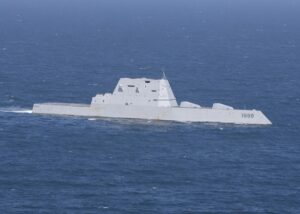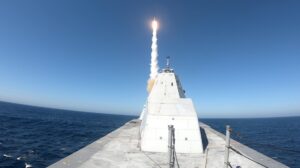The Navy is planning to conduct a hypersonic missile test launch off the USS Zumwalt (DDG-1000) by December 2025, an official said recently.
“So timeline-wise…we’re supposed to do a test shot no later than December of ‘25 is the expectation. In order to make that happen, part of it is good old [Surface Warfare Officer] micromanagement. There are no less than five captains involved in making sure this happens,” Capt. Tyson Young, program manager at Program Executive Office for the Z
umwalt Integrated Combat System (PEO IWS 9.0), said Feb. 1 during a panel discussion at the American Society for Naval Engineers’ annual Combat Systems Symposium.

Young noted the prime contractor for his portion of integrating the Conventional Prompt Strike (CPS) hypersonic missile onto DDG-1000 is Raytheon Technologies [RTX].
“They’re the prime contractor in daily developmental and technical interchanges, we do no less than five updates a week on what current statuses are,” he said.
Young also said beyond managing the program manager process he is working on developmental and technical changes to deploy the CPS on DDG-1000.
“We’re integrating an underwater weapons control system with [tactical support center, TSC] control in order to affect the data and message transfer to launch the missile…We are virtualizing both sets of control systems. So my [integrated combat system] and our TSC…will do lab testing next month and then we’re going to do an onboard ship demo both in port and underway – at least validate the message traffic going back and forth between the two combat systems.”
He noted one of the driving factors behind the current process is making sure the CPS meets all underwater requirements, because the Navy also wants to integrate the hypersonic weapon onto the Virginia-class attack submarines by 2029.
“So we’re attacking that through what we’re calling minimal integration…with its capability to reduce the amount of risk associated with that software development and that combat system,” Young said.
The Navy plans to replace the unused gun system on DDG-1000 with CPS via four 87-inch large diameter missile tubes during an 18-month drydock availability starting in late 2023 and running into 2025. Each tube will hold multiple missiles. The Zumwalt is set to be the second platform to field the weapon following an initial Army deployment later this year.
In November, Vice Adm. Johnny Wolfe, the Navy’s director for Strategic Systems Programs, said the main challenge in DDG-1000 CPS integration is just the timeline to 2025 and confirmed the work will not be done before the end of 2025 given the work involved (Defense Daily, Nov. 8).

Wolfe also said the Navy was “very well on our way” for combat system integration with the CPS system because the Army also needs it first this year. He noted 2023 testing will involve the combat system, which will help both Army and Navy development.
Young also underscored his experience of flexibility from the fleet and type commanders (TYCOM) to experiment with the Zumwalt and its combat system during its operational employment in the 7th Fleet last year.
DDG-1000 returned to its homeport of San Diego in November following a three-month employment to the Western Pacific (Defense Daily, Nov. 17).
“The fleet basically said…you’ve got a lot of things you can update and go to fix and figure out on the ship for her first employment – carte blanche do whatever you want to do. So when TYCOM and the fleet says do what changes you need to do to make sure that she’s operational and she’s functional, that we understand the history of the program, it’s kind of nice to get that backing from the fleet,” Young said.
“I give them the realization that I’m not going to make some change in the combat code or the software computer program that’s going to regress capability, but bring added capability or fix efficiency in the code or stability in the baseline,” he added.
Last month, the Navy awarded HII [HII] a contract to plan the modernization work to install the CPS weapons onto the Zumwalt-class destroyers. The work will occur at HII’s Ingalls Shipbuilding facility in Pascagoula, Miss., and is expected to be ready by December 2023 (Defense Daily, Jan. 9).